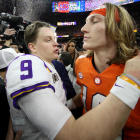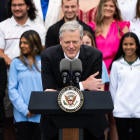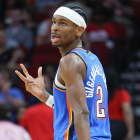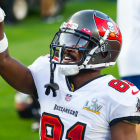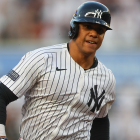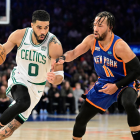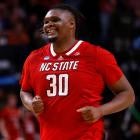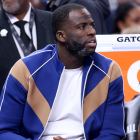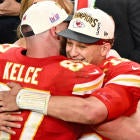How would Joe Burrow stack up to Trevor Lawrence? How about if we threw Lamar Jackson or Josh Allen in the mix? What about Kyler Murray, Drew Lock, and Tua Tagovailoa?
Although these questions relate to the same position, this exercise can be likened to comparing apples to oranges to grapes. There's no perfect way to rank a collection of players mixed between the NFL and college.
Based on what we know from the first two years in the NFL from the famed 2018 quarterback group, the rookie seasons from the 2019 quarterback class, what we saw in college from the 2020 class, and projecting the 2021 class forward, below is how I'd rank the passers from 2018 all the way to 2021, if these quarterbacks were all in a draft right now.
I'm comparing across levels based on everything we know about each quarterback's talent today, and what they've shown on a field to date. Of course, even an average season in the NFL is much more difficult than an amazing collegiate campaign. But for the sake of this article, the 2020 and 2021 quarterbacks are ranked mostly due to how much individual success I believe they will have in the pros based on their talent and overall skill sets.
1. Lamar Jackson, Ravens
The NFL's reigning MVP wasn't the perfect prospect but did enter the league with polish in key areas of playing the position, such as drifting away from pressure within the pocket, gliding through his progressions -- in Bobby Petrino's classic NFL system at Louisville -- and he possessed historic levels of play-making ability with his legs.
The latter element of his game exemplifies the new-age style of succeeding at quarterback in the pros. Jackson is rare cat athletically. He effortlessly ran for 1,206 yards at 6.9 yards per attempt in 2019, and while he can still grow as a passer, he took a sizable step forward in that area from his rookie year to his second season in Baltimore. Per PFF, Jackson had a 118.5 quarterback rating from a clean pocket in 2019 and managed a 97.7 rating while pressured.
He's an elite-dual threat quarterback at the forefront of a new era of quarterbacking in the NFL.
2. Trevor Lawrence, Clemson
Lawrence had a mediocre-at-best start to 2019, but after the midway point in the season, he was lights out -- until the national title loss. Traits-wise, Lawrence is Andrew Luck 2.0 as a prospect. Huge arm, solid accuracy to all levels, fast processing of coverages, natural pocket presence, a tendency to keep his eyes up with chaos around him, and high-level athleticism to create with his legs.
He had a phenomenal, unprecedented true freshman season in 2018 when all those advanced skills were on full display every week en route to a championship. The talent around him at Clemson is certainly among the best in the country, yet Lawrence is not simply a product of his environment. He's the perfect quarterback for the modern-day NFL because of the luxuries provided by his improvisational capabilities and scrambling talent.
3. Joe Burrow, LSU
Burrow emphatically checked all the quarterback evaluation boxes in a legendary 2019 season at LSU, a campaign nearly impossible to see coming. While the arrow seemed to be pointing up for the Ohio State transfer over the final few games in 2018, he did not look like someone ready to set every defense he faced on fire.
Burrow is amazingly accurate to all levels of the field -- particularly deep -- doesn't hang on one read too long, possesses inherent pocket-drifting mastery, and is legitimately Patrick Mahomes-esque when creating outside the structure of the play and finding targets down the field. Burrow diced up top SEC defenses all season, scorched Clemson in the national title game, and displayed grizzled veteran-like toughness along the way.
His arm isn't gargantuan, yet it's plenty strong enough for the NFL level. Burrow should make a quick transition to the NFL game in Zac Taylor's offense and instantly elevate the Bengals offense.
4. Justin Fields, Ohio State
The No. 2 recruit in the 2018 class -- behind only Lawrence -- Fields has been an impeccable talent since high school, and following split-time duty at Georgia, he erupted in 2019 after his transfer to Ohio State.
At 6-3 and 221 pounds, Fields has a filled-out, athletic frame and scrambles with ease when receivers aren't open. He has tantalizing arm talent and a quick, smooth delivery. Everything seemingly comes naturally to him. In the Buckeyes' spread offense, Fields repeatedly made the correct decision when throwing the football, and his passes arrived well-placed with zip to all levels. Even nitpicking him is hard, because he only put a small collection of bad plays on film last season when he completed over 67% of his passes with 41 touchdowns and only three interceptions at 9.2 yards per attempt.
Like Lawrence, he's ahead of most young quarterbacks when it comes from winning inside the pocket and can win with his legs. If he takes even a small step forward in his second full season at Ohio State, Fields will be get No. 1 overall pick consideration.
5. Tua Tagovailoa, Dolphins
Tagovailoa was advanced as a prospect in two vital areas -- accuracy and pocket management. From the moment he stepped onto the field at Alabama, his ball placement was special. And he understands he can't drop his head when moving away from oncoming rushers inside the pocket and drifts awesomely.
But he's an average athlete for the position by NFL standards. The same goes for his arm. While he flashed the ability to move through his progressions, a strange tendency pops on film when Tagovailoa locks onto read No. 1 far too long, which gives defenders ample time to make a play on the football.
Don't get me wrong though -- Tagovailoa enters the NFL without many clear-cut flaws when it comes to the fine details of playing the quarterback position.
6. Josh Allen, Bills
A surprise this high on the list after where he was as a ultra-talented but equally as raw prospect and a shaky rookie season in the NFL, Allen took a large step forward in Buffalo in 2019.
Despite his monstrous arm, Allen was dreadful on long balls in his second NFL season, but was fantastic at the short-to-intermediate levels of the field, combined areas that made up nearly 85% of his throws. Sure, there were a few off-target swing passes but significantly more lasers through small windows. Behind a sturdier offensive line than what was provided to him in 2018, Allen was more patient standing and surveying yet didn't become a statue, as that would be a failure to accentuate his entire skill set.
As a runner, he accumulated 510 yards on 109 carries and scored nine touchdowns. The arrow is tilted up for Allen.
7. Kyler Murray, Cardinals
Murray did a more than admirable job behind Arizona's ghastly blocking unit as a rookie in Kliff Kingsbury's system. His 64.4% completion percentage was buoyed by a steady diet of screens, and he had a pair of ugly two-game stretches early and late in the season.
Other than that, Murray took what defenses gave him and ripped a few jaw-dropping throws each game, passes that hinted at future brilliance. His running wasn't as much of a weapon as it was in the Big 12, but it's a part of his game almost assured to be utilized by Kingsbury in Year 2 and beyond.
8. Baker Mayfield, Browns
Mayfield had a strong rookie season, yet proper context was mostly glossed over. His six games with a passer rating over 100 came against defenses that had the following finishes in Football Outsiders' defensive DVOA: 21st, 22nd, 28th, 31st (2x), 32nd.
But, despite the relative ease of the defense against which he played exceptionally, a quarterback rating performance over 100 in the NFL isn't easy, and Mayfield demonstrated a fun blend of gun-slinger mentality and stellar accuracy in Year 1. He was mostly comfortable in the pocket too.
Even with Odell Beckham added to the roster in 2019, Mayfield took a big step back. His offensive line rarely did him any favors, yet he invited pressure and ran into it much more frequently than he did as a rookie. And as a lower-level athlete, he doesn't bring much impact as a runner. Also, Mayfield threw with less decisiveness and worse ball placement overall. But his numbers -- 59.4% completion, 78.8 rating -- were not fully indicative of his play. Most games featured a handful of beautiful tosses, it's just not all of them were caught and some ended as unlucky interceptions. Still, Mayfield has to play with much more poise in 2020 if he's to return to the type of player he was as a rookie.
9. Drew Lock, Broncos
Lock was difficult to peg in these rankings because he only appeared in five games in 2019. But he was my No. 1 quarterback prospect in his class -- slightly ahead of Murray -- but would've been behind most of the passers in the 2018 class.
Essentially, I'm conservatively slotting him in these rankings mostly due to a small NFL sample size from him to this point in time.
Lock started with a bang -- he looked more than comfortable in his opening two starts before cooling down in his final three contests -- but encouragingly never had a true stinker. Even his 18-of-40, 208-yard, one-interception showing in a 23-3 loss to the Chiefs came during a 24-degree snowstorm and featured a handful of impressive throws.
True to his collegiate form, the 2019 second-rounder was ultra aggressive when he saw fit and placed some dimes down the field in his late-season audition. He needs to get better moving through his reads and removing some ill-advised, off-balanced throws from his game. But Lock's arm strength stands out on film, as does his athleticism as a scrambler.
10. Justin Herbert, Chargers
Herbert was on the draft radar for two years and, strangely, hype subsided for him in a mostly successful senior season that finished with a Rose Bowl win over Wisconsin.
With a cannon arm and fine athletic talent, Herbert checks the two boxes easiest to uncover on film. And, many times during his illustrious career at Oregon, he had outings that featured a variety of jaw-dropping throws at the intermediate level and down the field. As a senior, he stepped out of the limelight offensively, as the Ducks went full ground-and-pound with one of the best and most experienced offensive lines in the country.
Herbert is typically poised and accurate from the pocket, and he flashed phenomenal throw-on-the-run skill. There were glimpses of coverage-reading confusion and wayward ball placement. Most of those occurrences happened in Oregon's biggest, most marquee contests. Those blips are concerning, but having evaluated him for two full seasons, I like what Herbert brings to the field athletically, with his arm strength, and in the majority of cases, from a mental/processing standpoint.
11. Sam Darnold, Jets
Darnold was a #DraftTwitter darling during the 2018 pre-draft process. I wasn't as awestruck by him. He finished as my QB4 in that class with a late first-round grade. The adoration for Darnold stemmed from a fantastic, out-of-nowhere redshirt freshman season in which Darnold took over as the USC starter in late September. He completed over 67.2% of his passes with 31 touchdowns and nine interceptions at 8.4 yards per attempt as a 19 year old. His film was littered with high-level throws fit into tiny windows down the field.
He took a step back in his super-hyped 2017 campaign -- he led Division I in turnovers -- but the big-time throws still popped up on film throughout the season. With the Jets as a rookie, Darnold took a fair amount of time to acclimate to the NFL as such a young starter -- mostly struggling mightily against pressure -- but ended on a three-game tear with five touchdowns, no picks at 7.5 yards per attempt and 63.1% completion.
His second season was marred by a case of mono that kept him out of three contests, Adam Gase's ultra-conservative offense and New York's porous offensive line that did him no favors. The elite-level flashes were there, but they were few and far between. His pocket presence was average, and some of the aggressive nature he flashed at USC and as a rookie subsided.
12. Daniel Jones, Giants
Jones demonstrated he was capable of outstanding throws at the intermediate level and down the field, and he mostly worked well underneath in Pat Shurmur's West Coast Offense as a rookie. Those positives were countered by a propensity to be careless with the football, both in the pocket and by way of throwing passes into precarious situations.
Like many young quarterbacks, he was mostly frantic against pressure, and while a few awesome throws were made under duress, Jones released many more off-balanced passes from a muddy pocket that were (or should've been) intercepted. He tossed 12 picks but that number very easily could've been much higher if some defensive backs had more reliable hands.
As someone who thought Jones was drafted much too high, I was impressed by his downfield ball placement -- not a strength at Duke. His quick release and accuracy on short throws were elements of his game he regularly displayed in college and instantly appeared during his rookie season.
13. Dwayne Haskins, Redskins
At Ohio State, Haskins parlayed a historic season -- 70.8% completion and 50 touchdowns to just eight interceptions -- into being a top 15 pick.
But for as gaudy as his statistics were during his single year as the Buckeyes starter, Haskins' lacked quickness in his feet to avoid pressure in the pocket and wasn't noticeably accurate down the field. Also, Ohio State's offensive line was sturdy, and Haskins' collection of skill-position players was ridiculous. He was more of a project than his numbers indicated.
Yet, when he did see the field in the NFL from Week 10 through the rest of the season, Haskins did make a few pinpoint throws deep and showed slightly improved pocket mobility, although neither would now be considered a strength. He quickly checked down and had severe problems against pressure in most occasions. However, Washington's offensive line was brutal, and outside of Terry McLaurin, the Redskins were mostly devoid of skill-position talent.
14. Jordan Love, Packers
Love is the ultimate long-term project at the quarterback spot. But he has first-round talent. In 2018, with a tiny collection of NFL talent around him, Love threw 32 touchdowns to just six picks at 64.0% completion and 8.6 yards per attempt. His senior season didn't go nearly as well. His statistics took a noticeable dip, and he frequently put the ball into harm's way, often not noticing underneath defenders or throwing late toward the sideline.
Despite all that, Love has freaky arm talent and natural athletic gifts, a combo that allows him to make Mahomesian throws to all levels of the field, from any platform, in any situation. He can win from the pocket too but has to sharpen his rough edges in that aspect of his game in order to succeed in the NFL.
15. Josh Rosen, Dolphins
Everyone missed on Rosen in the 2018 Draft. And he's the cautionary tale of how the aesthetics of a quarterback's play can be wildly deceiving.
A prized recruit at UCLA, Rosen looked like an NFL quarterback starting in his freshman season with the Bruins. His footwork was incredibly clean, his release was perfect, and he threw a gorgeous tight spiral to every level. He flashed good pocket management skills too.
He looked the part and was universally liked. He finished as my QB3 in the 2018 class.
But in the NFL, his unreliable downfield accuracy, mostly hurried play against pressure, and a tendency to stand in and take gigantic hits inside the pocket as opposed to avoiding them catalyzed a terrible rookie campaign. His situation in Arizona was atrocious, yet Rosen rarely if ever flashed the ability to overcome, and he's not the type of athlete to make off-script plays on a regular basis.
In his short audition with the Dolphins in 2019, the same issues materialized for Rosen behind, yes, another abysmal blocking unit. To his credit, amazing throws did happen early in the season. History says Rosen won't be be a franchise quarterback in the NFL, and he probably never had that type of complete skill set. But he has been dealt a bad hand twice in two seasons on different teams.












